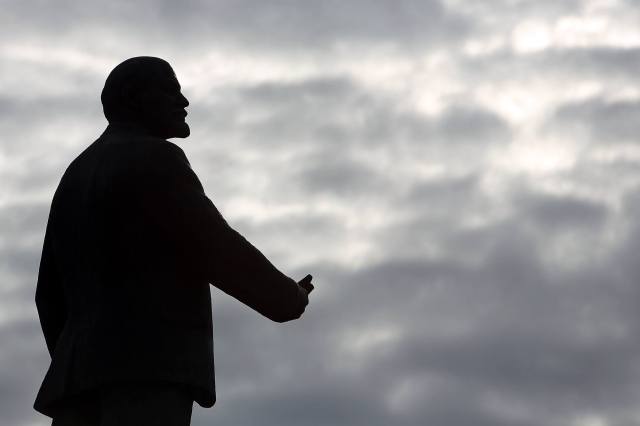Credit: Spencer Platt / Getty

I had an odd reading journey recently. I was led by historical fiction into historical fact, and – although the history it recounted was dark and frightening – I found it oddly heartening, as a reminder that 2018 is not a terrible time to be alive.
It started with film. I was watching Armando Iannucci’s The Death of Stalin, which portrays the last hours of the dictator’s life and the scrabble for power afterward in bleakly hilarious fashion, and then Bridge of Spies, the Tom Hanks espionage vehicle, and I realised: I know embarrassingly little about the Cold War.
It’s not that I didn’t know anything. I lived through about a decade of it, for a start. But I mainly knew the big events, and mainly either as little more than names, or as set-pieces somewhat devoid of context: the Cuban missile crisis, the Berlin airlift. I didn’t have a good grasp of the sweep of it, how all the pieces fitted together.
Someone recommended to me The Cold War by John Lewis Gaddis, a much-respected historian of the period. It’s not a long book – fewer than 300 pages, not counting the references and index, which isn’t much when you’re cramming in the better part of a century of complex geopolitical history. But it covers that ground brilliantly. It doesn’t travel in strict chronological order, but breaks the narrative up into various themes that Gaddis considers relevant, such as “Command vs Spontaneity”, on the differences between the two ideologies that faced each other, or “Actors”, on the individual men and women (Reagan, Gorbachev, Thatcher, Walesa, John Paul II) who “widened the range” of historical possibilities and helped bring the conflict to an end. It’s a brilliant, quick overview of a vital part of history.
While it was fascinating, though, it only really went back to 1917, and, when in passing it described Lenin’s accession to power as a “coup d’etat” rather than a popular movement, it occurred to me that I didn’t know much about the Russian Revolution either. So I looked on Amazon, which recommended Orlando Figes’s A People’s Tragedy. That was a very, very different book – 900 pages, and rather than skimming over decades in a few pages, it might, for example, spend a similar number of pages examining serfs’ farming techniques in a particular village a few miles outside Moscow in 1888. It was, it should be admitted, a fair old slog, and I kept getting bogged down and wandering off to re-read old Iain M Banks books. But I know an awful lot more about the Russian Revolution than I used to. If you’re in the market for a properly in-depth discussion, it’s worthwhile.
A similar journey happened to me with the English reformation. I started by reading Dissolution, book one of CJ Sansom’s Shardlake series, about a 16th-century lawyer whom Thomas Cromwell asks to solve a murder. Then I read book two, and then books three to six. They’re gripping and evocative, if a little silly, and I was hooked. Having done that, on the recommendation of a friend I read An Instance of the Fingerpost, by Iain Pears, set in the aftermath of the English Civil War, which similarly revolves around politics and murder, but is a much cleverer and more moving work.
But, once again, I realised: I don’t know enough about the English reformation. In fact, I don’t know enough about British history in general. I’ve spent a lot of my life reading about science, but very little about history. So I embarked on Simon Schama’s splendid A History of Britain (volume 1), which takes us from Stone Age settlements to the last days of the reign of Queen Elizabeth the First (spoiler: she dies at the end).
I said at the beginning that I found these books oddly heartening. And I did. Because although we think we’re divided as a society now, with Brexit and the culture war, at least we’re not as divided as Tudor England, when the Protestant/Catholic divide nearly drove us to civil war on several occasions (and arguably did, depending on whether you count the Pilgrimage of Grace and the other rebellions against the crown as “civil wars”). And we don’t have the tsarist Third Section secret police, or the Soviet Cheka, or William Cecil’s network of informers, listening to whispers from neighbours about whether we’ve ever spoken ill of the Tsar or Comrade Stalin or Queen Bess. And even though we think we live in a dangerous time, we no longer have two impossibly powerful states staring at each other through the radar screens of nuclear missiles, fingers on the buttons.
Maybe this is naive. I’m a naturally optimistic person; maybe someone else, of a more pessimistic – or as they would see it, realistic – disposition, would read the same books and think “this shows us how easy it is to go from this world of ease and peace to darkness and violence”. The question, perhaps, is whether we should assume that the (relatively) peaceful time we live in is now the norm, and we have left that darkness in our past, or whether it is a thin veneer that we have built over a pit of despair and that could be stripped away at any moment.
But for me, at least, it felt like a reminder. Things aren’t perfect now. But human progress is real, and we have made the world a lot better than it was 50, or 100, or 500 years ago.










Join the discussion
Join like minded readers that support our journalism by becoming a paid subscriber
To join the discussion in the comments, become a paid subscriber.
Join like minded readers that support our journalism, read unlimited articles and enjoy other subscriber-only benefits.
Subscribe